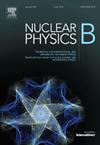New generation Cherenkov telescope array: HADAR and its performance introduction
IF 2.8
3区 物理与天体物理
Q2 PHYSICS, PARTICLES & FIELDS
引用次数: 0
Abstract
Astrophysical very high energy (VHE) gamma-rays are believed to result almost exclusively from the interactions of populations of highly relativistic particles with ambient matter or photon fields. The study of these VHE photons therefore allows us to examine the processes of particle acceleration in the Universe, and the extreme environments in which they occur.To explore the origins and properties of gamma-rays, the High Altitude Detection of Astronomical Radiation (HADAR) experiment has been proposed to study these events. The refractive atmospheric Cherenkov telescope, a key component of HADAR, features a wide field of view (FOV) and exceptional sensitivity. It is designed to indirectly detect gamma-rays by capturing Cherenkov radiation produced by extensive air showers initiated by primary gamma-rays. This study concentrates on the design and performance parameters of the refractive atmospheric Cherenkov telescope array.
新一代切伦科夫望远镜阵列:HADAR及其性能介绍
天体物理学的高能(VHE)伽马射线被认为几乎完全是由高度相对论性粒子群与周围物质或光子场的相互作用产生的。因此,对这些VHE光子的研究使我们能够检查宇宙中粒子加速的过程,以及它们发生的极端环境。为了探索伽玛射线的起源和性质,人们提出了高空天文辐射探测(HADAR)实验来研究这些事件。折射大气切伦科夫望远镜是HADAR的关键组成部分,具有宽视场(FOV)和卓越的灵敏度。它的设计目的是通过捕获由初级伽玛射线引发的大量空气阵雨产生的切伦科夫辐射来间接探测伽玛射线。对折射大气切伦科夫望远镜阵列的设计和性能参数进行了研究。
本文章由计算机程序翻译,如有差异,请以英文原文为准。
求助全文
约1分钟内获得全文
求助全文
来源期刊

Nuclear Physics B
物理-物理:粒子与场物理
CiteScore
5.50
自引率
7.10%
发文量
302
审稿时长
1 months
期刊介绍:
Nuclear Physics B focuses on the domain of high energy physics, quantum field theory, statistical systems, and mathematical physics, and includes four main sections: high energy physics - phenomenology, high energy physics - theory, high energy physics - experiment, and quantum field theory, statistical systems, and mathematical physics. The emphasis is on original research papers (Frontiers Articles or Full Length Articles), but Review Articles are also welcome.
 求助内容:
求助内容: 应助结果提醒方式:
应助结果提醒方式:


